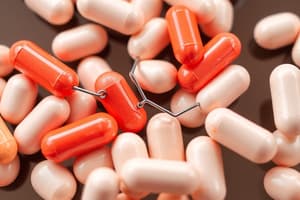Podcast
Questions and Answers
What is the essential structural component for the antibacterial activity of beta-lactam antibiotics?
What is the essential structural component for the antibacterial activity of beta-lactam antibiotics?
- A carboxyl group.
- A thiazolidine ring.
- An intact beta-lactam ring. (correct)
- A side chain attached to a benzene ring.
Which of the following is a major mechanism of bacterial resistance to beta-lactam antibiotics?
Which of the following is a major mechanism of bacterial resistance to beta-lactam antibiotics?
- Enzymes that disrupt the beta-lactam ring. (correct)
- Increased drug permeability.
- Changes in bacterial DNA.
- Reduced ribosome activity.
Which class of antibiotics inhibits bacterial cell wall synthesis by binding with penicillin-binding proteins and is considered a broad-spectrum, bactericidal beta-lactam antimicrobial?
Which class of antibiotics inhibits bacterial cell wall synthesis by binding with penicillin-binding proteins and is considered a broad-spectrum, bactericidal beta-lactam antimicrobial?
- Penicillins.
- Cephalosporins.
- Carbapenems. (correct)
- Monobactams.
What is a key nursing action to take before administering all drugs, especially penicillins?
What is a key nursing action to take before administering all drugs, especially penicillins?
A patient is prescribed a monobactam. Which of the following characteristics makes it a good choice for patients with certain sensitivities?
A patient is prescribed a monobactam. Which of the following characteristics makes it a good choice for patients with certain sensitivities?
A patient with a severe skin infection who also has a history of kidney problems needs treatment with a beta-lactam antibiotic. Which of these would be a good choice based on its safety profile?
A patient with a severe skin infection who also has a history of kidney problems needs treatment with a beta-lactam antibiotic. Which of these would be a good choice based on its safety profile?
What is the primary rationale for combining a penicillin and a beta-lactamase inhibitor drug?
What is the primary rationale for combining a penicillin and a beta-lactamase inhibitor drug?
A patient has a urinary tract infection, lower respiratory tract infection, and has been diagnosed with septicemia. Which of the following beta-lactam antimicrobials might be considered an appropriate choice to treat all of these conditions?
A patient has a urinary tract infection, lower respiratory tract infection, and has been diagnosed with septicemia. Which of the following beta-lactam antimicrobials might be considered an appropriate choice to treat all of these conditions?
Which of the following is a reason for the increasing use of single daily doses of aminoglycosides?
Which of the following is a reason for the increasing use of single daily doses of aminoglycosides?
Why is it important to measure serum drug levels during aminoglycoside therapy?
Why is it important to measure serum drug levels during aminoglycoside therapy?
Which of the following measures can help decrease nephrotoxicity and ototoxicity associated with aminoglycosides?
Which of the following measures can help decrease nephrotoxicity and ototoxicity associated with aminoglycosides?
A key difference between aminoglycosides and fluoroquinolones is the type of infections they are primarily effective against. Which of the following is an accurate comparison?
A key difference between aminoglycosides and fluoroquinolones is the type of infections they are primarily effective against. Which of the following is an accurate comparison?
Which of following patient factors influence the selection and dosage of aminoglycosides and fluoroquinolones?
Which of following patient factors influence the selection and dosage of aminoglycosides and fluoroquinolones?
Macrolide antibiotics are known for which characteristic in their distribution within the body?
Macrolide antibiotics are known for which characteristic in their distribution within the body?
Macrolides are commonly used in all the following situations EXCEPT:
Macrolides are commonly used in all the following situations EXCEPT:
Macrolides can be either bacteriostatic or bactericidal, which factor primarily determines this effect?
Macrolides can be either bacteriostatic or bactericidal, which factor primarily determines this effect?
Which of the following is NOT a typical adverse effect associated with macrolide antibiotics like erythromycin?
Which of the following is NOT a typical adverse effect associated with macrolide antibiotics like erythromycin?
Which of the following best describes the typical initial presentation of tuberculosis infection?
Which of the following best describes the typical initial presentation of tuberculosis infection?
Why is multidrug therapy a crucial strategy in the treatment of tuberculosis?
Why is multidrug therapy a crucial strategy in the treatment of tuberculosis?
Which of the following correctly identifies a primary concern related to extensively drug-resistant tuberculosis (XDR-TB)?
Which of the following correctly identifies a primary concern related to extensively drug-resistant tuberculosis (XDR-TB)?
A patient is diagnosed with tuberculosis. What is a key factor that contributes to the development of drug-resistant TB strains?
A patient is diagnosed with tuberculosis. What is a key factor that contributes to the development of drug-resistant TB strains?
A patient with a known history of Myasthenia gravis is prescribed azithromycin for a respiratory infection. What is a vital consideration with this patient's prescribed therapy?
A patient with a known history of Myasthenia gravis is prescribed azithromycin for a respiratory infection. What is a vital consideration with this patient's prescribed therapy?
Which statement accurately describes the progression of tuberculosis?
Which statement accurately describes the progression of tuberculosis?
What is a significant global health concern regarding tuberculosis?
What is a significant global health concern regarding tuberculosis?
Flashcards
Beta-lactam Antibiotics
Beta-lactam Antibiotics
A class of antibiotics that share a common chemical structure, the beta-lactam ring. This ring is crucial for their antibacterial activity.
Penicillins
Penicillins
Penicillins are a type of beta-lactam antibiotic that are effective against a wide range of bacteria. They work by inhibiting the synthesis of bacterial cell walls.
Beta-lactamase Resistance
Beta-lactamase Resistance
The breakdown of the beta-lactam ring by enzymes produced by bacteria. This renders the antibiotic ineffective.
Beta-lactamase Inhibitors
Beta-lactamase Inhibitors
Signup and view all the flashcards
Penicillin + Beta-lactamase Inhibitor
Penicillin + Beta-lactamase Inhibitor
Signup and view all the flashcards
Cephalosporins
Cephalosporins
Signup and view all the flashcards
Carbapenems
Carbapenems
Signup and view all the flashcards
Aztreonam
Aztreonam
Signup and view all the flashcards
Aminoglycosides: Key Uses
Aminoglycosides: Key Uses
Signup and view all the flashcards
Fluoroquinolones: What are they?
Fluoroquinolones: What are they?
Signup and view all the flashcards
Why single daily doses?
Why single daily doses?
Signup and view all the flashcards
Monitoring Aminoglycoside Levels
Monitoring Aminoglycoside Levels
Signup and view all the flashcards
Preventing Aminoglycoside Side Effects
Preventing Aminoglycoside Side Effects
Signup and view all the flashcards
Macrolides: What are they?
Macrolides: What are they?
Signup and view all the flashcards
Macrolide Uses: What are they good for?
Macrolide Uses: What are they good for?
Signup and view all the flashcards
Macrolides in Critical Illness
Macrolides in Critical Illness
Signup and view all the flashcards
Tuberculosis
Tuberculosis
Signup and view all the flashcards
Latent TB
Latent TB
Signup and view all the flashcards
Active TB
Active TB
Signup and view all the flashcards
Multidrug-Resistant TB (MDR-TB)
Multidrug-Resistant TB (MDR-TB)
Signup and view all the flashcards
Extensively Drug-Resistant TB (XDR-TB)
Extensively Drug-Resistant TB (XDR-TB)
Signup and view all the flashcards
Multidrug Therapy for TB
Multidrug Therapy for TB
Signup and view all the flashcards
Macrolide Antibiotics
Macrolide Antibiotics
Signup and view all the flashcards
Adverse Effects of Macrolides
Adverse Effects of Macrolides
Signup and view all the flashcards
Study Notes
Beta-Lactam Antibiotics
- Beta-lactam antibiotics are named for their beta-lactam ring structure.
- An intact beta-lactam ring is essential for antibacterial activity.
- Specific enzymes can disrupt the ring, inactivating the antibiotic.
- Mechanisms of action vary widely among different types of beta-lactam antibiotics.
Penicillins
- Discussion of penicillins includes effectiveness, safety, spectrum of antibacterial activity, mechanism of action, indications for use, administration, observation of patient response, and patient teaching.
- Importance of questioning patients about allergies before administering penicillins is highlighted.
Beta-Lactamase Inhibitor Drugs
- Characteristics of beta-lactamase inhibitor drugs are described.
Combining Penicillin and Beta-Lactamase Inhibitor
- Rationale for combining a penicillin and a beta-lactamase inhibitor drug is discussed.
Cephalosporins
- Discussion of cephalosporins includes effectiveness, safety, spectrum of antibacterial activity, mechanism of action, indications for use, administration, observation of patient response, and patient teaching.
Carbapenems
- Discussion of carbapenems includes effectiveness, safety, spectrum of antibacterial activity, mechanism of action, indications for use, administration, observation of patient response, and patient teaching.
- Carbapenems are broad-spectrum, bactericidal beta-lactam antimicrobials.
- They inhibit bacterial cell wall synthesis by binding to penicillin-binding proteins.
Monobactams
- Discussion of monobactam drug includes effectiveness, safety, spectrum of antibacterial activity, mechanism of action, indications for use, administration, observation of patient response, and patient teaching.
- Active against gram-negative bacteria.
- Does not commonly cause kidney or hearing damage.
Nursing Process for Beta-Lactam Antibacterials
- Implement the nursing process when caring for patients receiving beta-lactam antibacterials, including considerations such as perioperative use, children, older adults, abnormal kidney function, hepatic impairment, and patients with critical illness or home care needs.
Aminoglycosides and Fluoroquinolones
- Aminoglycosides:
- Increasing use of single daily doses of aminoglycosides is discussed.
- Importance of measuring serum drug levels during aminoglycoside therapy is discussed.
- Methods for reducing nephrotoxicity and ototoxicity with aminoglycosides are described.
- Characteristics of aminoglycosides and fluoroquinolones, relating to effectiveness, safety, spectrum of antimicrobial activity, indications for use, administration, and patient response observation.
- Factors influencing the selection and dosage of aminoglycosides and fluoroquinolones are detailed.
- Characteristics, uses, adverse effects, and nursing process implications of aminoglycosides and fluoroquinolones.
- Using aminoglycosides and fluoroquinolones in cases of abnormal kidney function and critical illness.
- Importance of judicious use to reduce antibiotic resistance is highlighted.
- Nursing process implementation for patients receiving aminoglycosides and fluoroquinolones.
- Fluoroquinolones:
- Fluoroquinolones are synthesized from quinolones.
- Quinolones were originally used for UTIs.
Macrolides
- Characteristics and specific uses of macrolide anti-infective agents are described.
- Azithromycin/Clarithromycin/Fidaxomicin and Erythromycin (prototype) are mentioned.
- Adverse effects: liver problems, hypersensitivities, preexisting liver disease, myasthenia gravis.
Tuberculosis and Mycobacterium avium Complex
- Mycobacterium avium complex: Characteristics, including the fact it's an infectious disease affecting primarily the lungs, but also lymph nodes, pleurae, bones, joints, kidneys, and the gastrointestinal tract.
- The disease-causing agent, Mycobacterium tuberculosis, is noted as a pathogenic bacterium, multiplying slowly, able to lie dormant for years, and resistant to phagocytosis, developing drug resistance.
- Tuberculosis occurrences, worldwide and in specific populations are discussed, including the impact of infection on specific groups.
- Tuberculosis phases (latent, active, and drug-resistant).
- Drug therapy for tuberculosis, including the rationale for multiple-drug therapy and concerns like drug resistance.
- Factors contributing to the development of drug-resistant tuberculosis, and the impact on treatment options.
- Strategies to increase patient adherence to anti-tuberculosis drug regimens.
- Nursing Considerations: Implementation of the nursing process in the care of patients undergoing drug therapy for tuberculosis including, delayed diagnosis, lack of adequate diagnostic labs, and medication efficacy.
Studying That Suits You
Use AI to generate personalized quizzes and flashcards to suit your learning preferences.




